|
Hi everyone! I’m back, and I can’t believe we’re already halfway through the TRIP program. I have learned so much in the past few weeks, from how to transfer and sort flies to different behavioral assays. My favorite part so far has been presenting my kickoff experiment to my peers. For this experiment, I studied the effects of Valerian and disrupted circadian rhythms on the sociability of fruit flies. To determine the sociability levels of the fruit flies, I placed them in chambers and calculated their distance after 15 minutes; the closer the distance between the flies, the more social they were. I found that Valerian increased sociability and constant darkness in flies (a.k.a disrupted circadian rhythms) decreased sociability. This piqued my interest in sleep deprivation, especially because of its relevance among teenagers. It feels like all high schoolers are constantly lacking sleep and self-medicating with coffee and energy drinks despite the potential negative effects. Naturally, I fell down a rabbit hole of researching energy drinks and their effects. Initially, I planned to study how sleep deprivation and energy drinks affect cognitive function for my independent research project. However, after discussing this idea with the instructors, I decided to tweak my project to focus specifically on energy drinks and their short-term and transgenerational effects on fruit fly motility. To study this, I will be performing the negative geotaxis and larval locomotion assays. I’m excited to see whether there are differences in motility between the short-term and transgenerational flies. I can’t wait to share my results in the next post!!
0 Comments
I can proudly say I’ve been a “lawyer” for the past two years. If I were to tell the story of how I joined the Mock Trial team, it would take a whole day, but I can keep it short and sweet; I remember passing objection notes to my brother from the corner of his desk while he faced the computer screen. This was during his online Mock Trial “trial.” Ever since those days, I’ve held onto my goal of competing at mock trials until I graduate. If it isn’t obvious yet, it’s one of my favorite communities. In three days, it will be our second round of competition, so we have been busy preparing nonstop. Wish us luck! Speaking of community, I feel myself most attached to my Muslim brothers and sisters out there. I don’t see many at my school, so I was excited to meet a hijabi at TRIP yesterday! I’m sure there are Muslims at my school that I haven’t had the chance to meet, so I’m in the process of starting a Muslim School Association (MSA) club by the end of this month. At the beginning of my high school career this year, I was eager to be a part of the MSA to connect with other Muslims. It’s common in other schools, but East didn’t have one yet, so now I’ve made it my goal to establish one as soon as possible. Hopefully, it will expand into a larger community as time goes by. By the end of these blogs, this club will be up and running.
Yesterday was our first day of TRIP. It was an exciting experience since I got to meet both of the directors, Dr. Leystra and Dr. Purdy, the teaching instructors, Dr. Valdes and Mr. Cozzone, and the teaching assistants, Anoosha and Niki. We got to try out the micropipettes and set up our drugs and stressors which we will be testing next class. At the beginning, I was nervous but as time progressed, we got to see a glimpse of what awaited us for the next three months. I can already tell we’ll make great memories with the team as I have met many goal-driven people. By working together, we’ll develop strong collaboration skills and leave Trip with useful ideas. I might start at zero today, but I aim to reach higher by the end of this trip. I’ve come here to sharpen my thinking skills and stretch my capabilities by challenging myself with the knowledge that I know I can achieve if I work hard enough. I truly want to make use of every opportunity that’s provided in this program.
Hi everyone! I can believe we’re almost halfway done with our TRIP experience! These past 5 weeks have been really helpful as I’ve learned many important lab skills such as calculating concentrations, performing assays, making grape plates, and collecting data. I’ve also grown significantly as a student. I can ask better questions, provide feedback to my peers, and effectively implement the feedback I receive. I am especially thankful for Dr. Leystra, Dr. Purdy, Dr. Valdes, our TAs, and my peers for all their help and support.
For my individual experiment, I want to explore the transgenerational effects of caffeine on anxiety. I was interested in observing caffeine and anxiety as both of these factors are significant in our society. 31% of adults experience anxiety and the average American consumes approximately 1000 mg of caffeine per day, while the FDA recommends limiting caffeine to 400 mg daily. Additionally, these two factors correlate as some of their symptoms overlap, such as increased heart rate and restlessness. Beyond this, it is believed that overindulgence in caffeine can cause feelings of anxiety. I can’t wait to start my experiment next week!
Hi everyone! It’s been a while! I can’t believe we are already halfway through our journey at TRIP! These past few weeks have been an incredible experience. I have learned and grown so much in the lab. I am able to measure liquids with a micropipette, make grape plates, analyze data, and my personal favorite, work with fruit flies! Currently I am finishing up my kick-off experiment; I tested how female fertility is affected by Red Clover (a perennial herb native to southeastern Europe) and a high sugar diet over a short period of time. To test this, I conducted the female fertility assay. This assay tells you how many unhatched embryos per female fly there are. After analyzing my data, I came to the conclusion that both Red Clover and a high sugar diet individually increased the number of embryos and female fertility, but the usage of both decreased the number of embryos per female in comparison to my control vial. As we finish up my kick-off experiment, now I am brainstorming ideas for my independent project. Due to my own experience with insomnia, I would like to test how sleep deprivation and the consumption of melatonin affect anxiety and female fertility. I am planning to expose some of my flies to constant light to deprive them from sleep, this would be the stressor of my experiment. As for the drug, some of melatonin’s known side effects are to induce anxiety and to reduce the effectiveness of contraceptives. I am very excited to see how this turns out because it directly impacts anyone who utilizes melatonin or experiences sleep deprivation. To test how these factors affect anxiety and female fertility, I would use the open field test to determine whether the flies are anxious, and the female fertility assay to find the number of embryos. The open field test is when you place a fruit fly in the middle of an agar plate, and depending on where or if the fly moves, you can determine whether it is anxious or not. For the female fertility assay, you essentially make an incubator with a grape plate and a conical tube. After a 2 hour incubation period, you count the number of embryos. I am very excited to see how this goes! I’ll make sure to update you guys soon!
Are you a fan of soda? Or many of the sweet treats that are consumed on the daily, such as M&Ms, Jolly Ranchers, and Skittles? Well, with my obsession with these sugar-inducing consumables, I consider myself a firm believer in the phrase, sugar brings happiness. But, is it just sugar in these delights that causes energy-boosts? Red 40, or scientifically known as Allura Red AC, is a synthetic food dye that we consume on a regular basis. Thrown in with a multitude of other ingredients, the true effect of Red 40 is lost to those wider-known properties, such as sugar. With these compelling thoughts in mind, my curiosity with Red 40 has made its presence known in my independent research question for this internship, which focuses on the effects of Red 40 on fruit flies, and whether or not it can cause anxiety. Licorice, with its anxiety-relieving properties, is another aspect of my research question, and will hopefully quench my curiosity for why the aftermath of sugar rushes isn’t so enjoyable. Overall, with exciting new nicknames and a wide variety of lab materials at my exposure, I’m excited to see what I’m capable of when going off on my own and conducting my own experiment, with the help and support of my fellow TRIP participants, and my instructors. II cannot wait to see the direction that my individual experiment takes me, and the exciting stories that my next few weeks being a part of TRIP will bring!
While I enjoyed conducting the Open Field Test during the kickoff experiment, for my independent project, I wanted to discuss the effects of Fenugreek and Shatavari on the female fertility of anxious flies. I was interested in stressing the flies by overcrowding the vials to make them anxious upon finding out that fertility rates in urban areas are less than fertility rates in rural areas. I wondered whether this was due to the population disparity between the two.
I’m so excited to start my independent project next week and am so grateful to be surrounded by peers who are as enthusiastic about their projects as I am. I’m excited to go through this journey together, and can not wait to begin my experiment!
Hi again! These past few fruit fly-filled weeks have been quite enjoyable, to say the least. While I was initially nervous about working with live flies, I’ve realized that it’s not as difficult as it seems. Finally getting to do actual lab work was rewarding; I learned a great deal about how to properly use flies for experimental testing. To start the experimental part of the program, we were all assigned kickoff experiments to help familiarize us with fruit flies and the various assays that we can perform. My project looked at the impact of a high sugar diet and fenugreek on fruit fly motility. Fenugreek is a plant native to parts of Asia and Europe that has been shown to have slight positive impacts on health, such as lowering blood sugar in diabetic and pre-diabetic people. I hypothesized that fenugreek would increase fly motility because of its overall positive impact on health, while a high-sugar diet would decrease fly motility because of the long-term negative effects that sugar has on health. In my experiment, I used the Negative Geotaxis Assay, which measures fly activity by seeing how far they can climb up a vial in 3 seconds. I learned an important lesson while performing this assay: don’t take blurry pictures. After running through the full assay, I realized that many of the pictures I had taken were unclear, making it hard to see where the flies were in the vials. As a result, I had to redo the whole assay again, each time making sure that all the flies were visible in the photos. Although it was inconvenient, making a mistake performing the assay helped me pay more attention to detail, which will hopefully come in handy down the line. After we finished our kickoff experiments, we started brainstorming for our independent projects. Coming into the program, I knew I wanted to study something related to addictive drugs and brain function, but I wasn’t really sure how that would translate into an independent project. The process of turning my interests into a project was definitely an interesting experience. The project that I originally had in mind involved measuring the ability of brain-damaged flies to become addicted to substances, but after talking with Dr. Purdy and Dr. Valdez, we came to the conclusion that it would not be relevant to helping overall human health. While I was initially demoralized, with their guidance, I was able to settle on a project that I was happy with. Addiction to substances has been shown to cause a decline in memory, so I wanted to see if there was any way that decline could be reversed. My whole life, my parents have told me that almonds improve memory, so I did some research as to why that is. I found out that almonds are high in Vitamin E, which reduces neurodegeneration by preventing cell damage. After finding that out, I decided that the question my project would answer would be, “Can Vitamin E ameliorate addictive drugs’ effect on memory?” I wanted to use developing brains for my project, so I decided to use the Larval Memory Assay. I am super excited to delve deeper into my project, and I can’t wait to find out what the results will be. Until next time!
Hello readers! We have some catching up to do since the last post. Last week, I presented my findings on how Black Cohosh (a type of herbal medicine) and disruptions in circadian rhythm impact fly fertility. Contrary to my hypothesis, I found that black cohosh and disrupted circadian rhythms had a lowering effect on the fertility of female flies. To produce my findings, I conducted a female fertility assay. The assay conditioned me to be observant, as counting embryos required attention to detail. When setting up the assay I learned a lot, like the fact that grape juice acts as a pheromone for flies. I now understand the purpose of grape plates. But I also noticed that to reach a definitive conclusion, I needed to repeat my trials to make sure that the results I got were not due to chance. As for the presentation…let's just say I am happy it was done. I enjoyed listening to my peers. (I need to remember the tips I got for the final symposium!).
So how do we make the parent flies anxious you ask? We will put the flies in the same tube with dead flies of their own species to induce a danger alert/alertness within the flies. If we find that conspecies death perception induces anxiety within the flies, it can show that Drosophila flies are more complex than what we previously thought. If we find that the progeny experienced negative effects without experiencing the anxiety-inducing situations themselves, this would open up a whole new realm of inheritance for the science world. It would certainly make parents more aware of what they do/experience in their lives before having children. Although the results in flies may not be directly applicable to human models, finding some kind of data would nonetheless contribute to the knowledge already known about inheritance from a non-genetic perspective. I cannot wait to see what kind of data I will get from this experiment. Thanks for reading! Until next time :)
Hello! I can’t believe that we have already finished out kick-off experiments and are beginning our independent projects! These past few weeks have flown by and I have already learned so much through this program. We prepared for our independent projects by learning how to sort flies by gender, prepare fly food, stress flies, how to collect data, and so much more! For my kick-off experiment, I investigated how Holy Basil and head trauma affect fly sociability. To do so, I had to sort flies on ice, place them into chambers, and use ImageJ to determine the average distance between the flies. I learned that the larger the average distance, the less social the flies are. Through this experiment, I learned a lot of useful tips that I can apply to my independent project. Additionally, I also learned how to avoid certain mistakes that I made during conducting this assay, such as forgetting to label my images. This experiment was very exciting and it was interesting to watch everyone performing their different assays!
These past weeks have been very informative and it was amazing to make so many new friends! I am very excited for what is to come and I cannot wait to see what everyone discovers through their independent projects!
Kickoff Experiment: Just Departed. Next Stop: The Independent Project! by Mariacristina Calcagno4/26/2024 Hello again! I’m shocked at how quickly my time in TRIP is flying by and amazed by how much knowledge I’ve been able to absorb, thanks to the wonderful structure of the program and the supportive community. Over the weeks since I last posted, I’ve been working on my kick-off experiment, building my confidence in working with the flies. In short, my experimental question asked about the effects of soap and holy basil on anxiety; the latter is often used for its antioxidant content and stress-relief effects. My assay was the open field test; it centers around the idea that compared to unstressed flies, the more anxious flies will spend increased time on the outer edges of a plate or more time in motion. I tested three flies per experimental condition. I recorded that the flies in the vial with soap but no holy basil spent, on average, more time in motion than the other vials; additionally, the only fly that crossed the center of the dish was from the soap-only vial. I’m now in the program phase of independent project design. I originally had an idea related to calorie-sensing and caloric exposure, but after discussing with instructors and my peer cohort, I will now be examining the effects of sleep deprivation and vitamin B6 on larval metabolism. I hope my assays yield interesting results!
|
Archives
April 2024
Categories
All
|


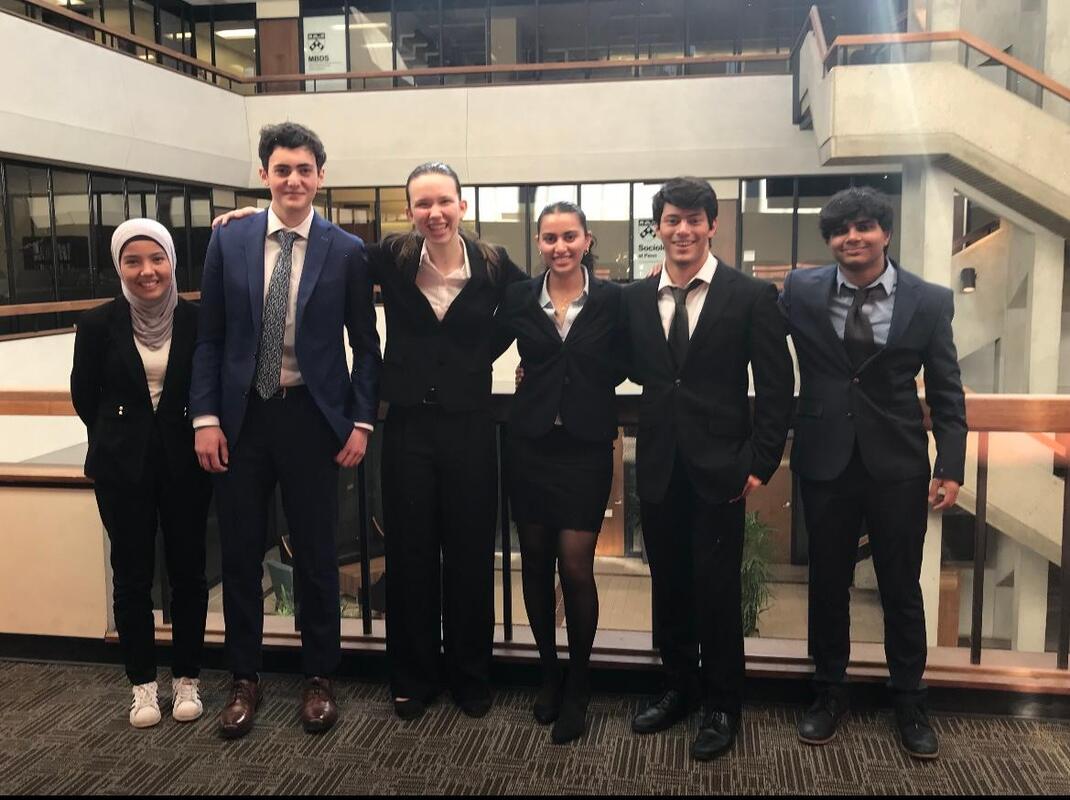


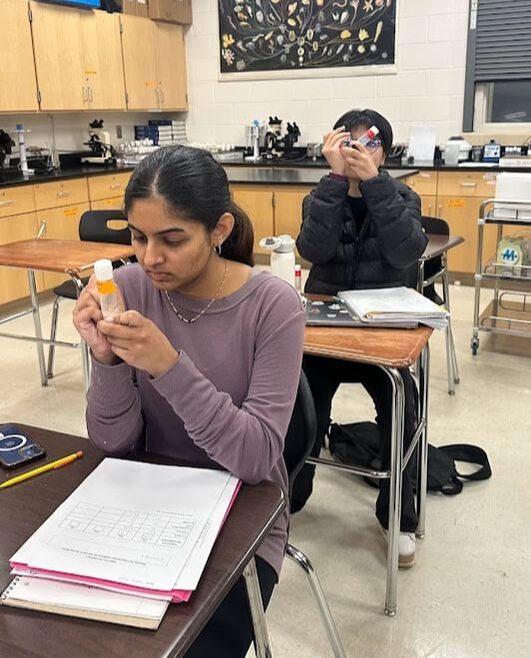
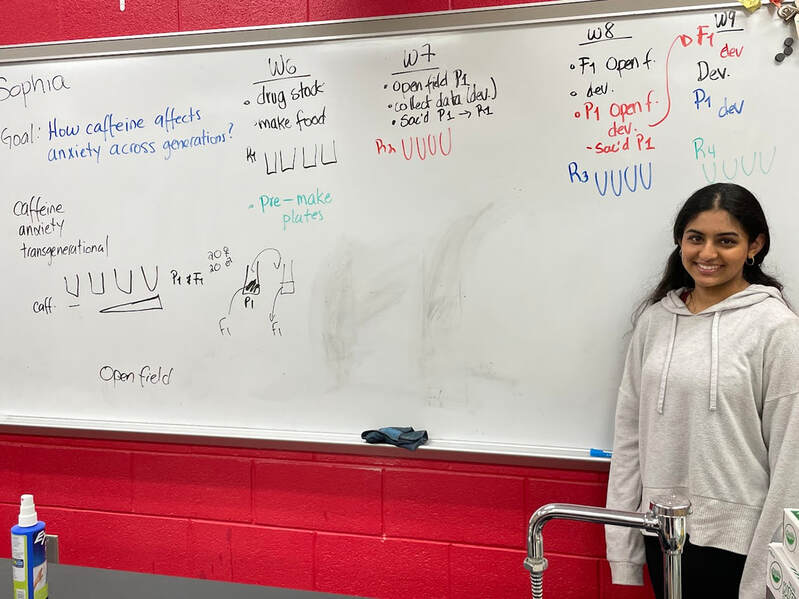
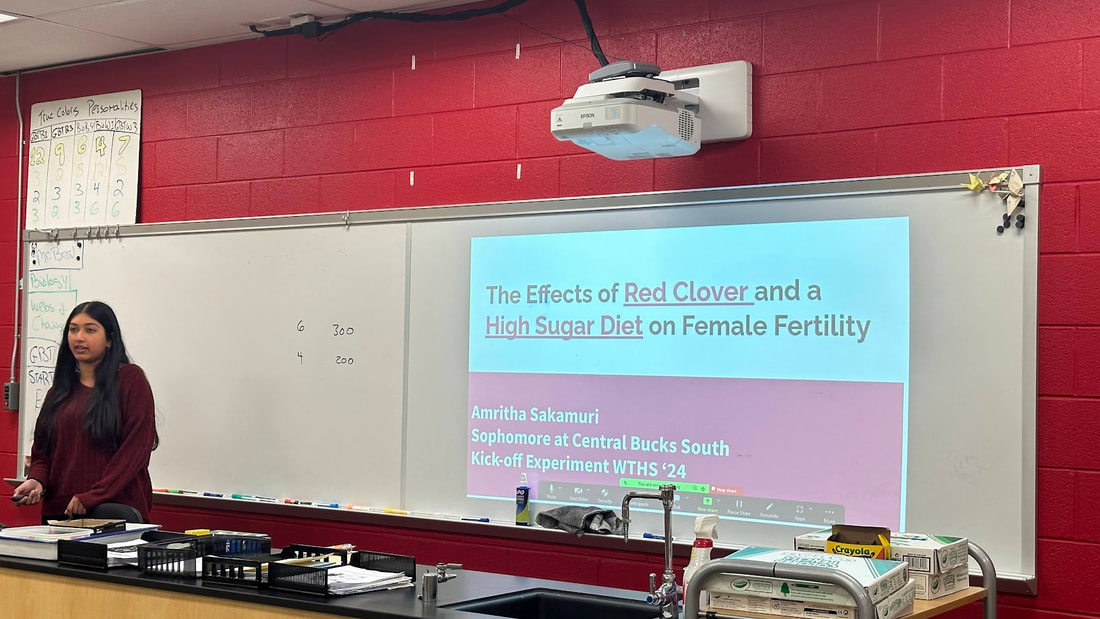
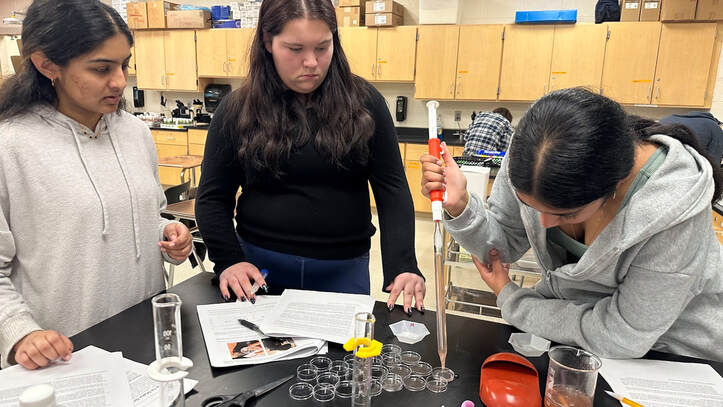
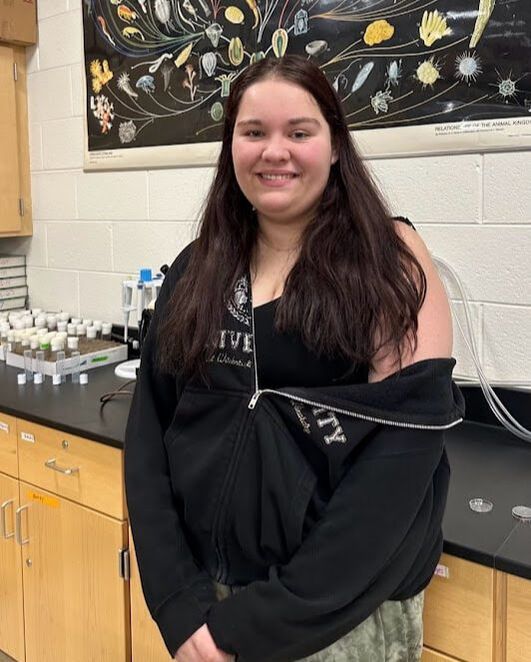
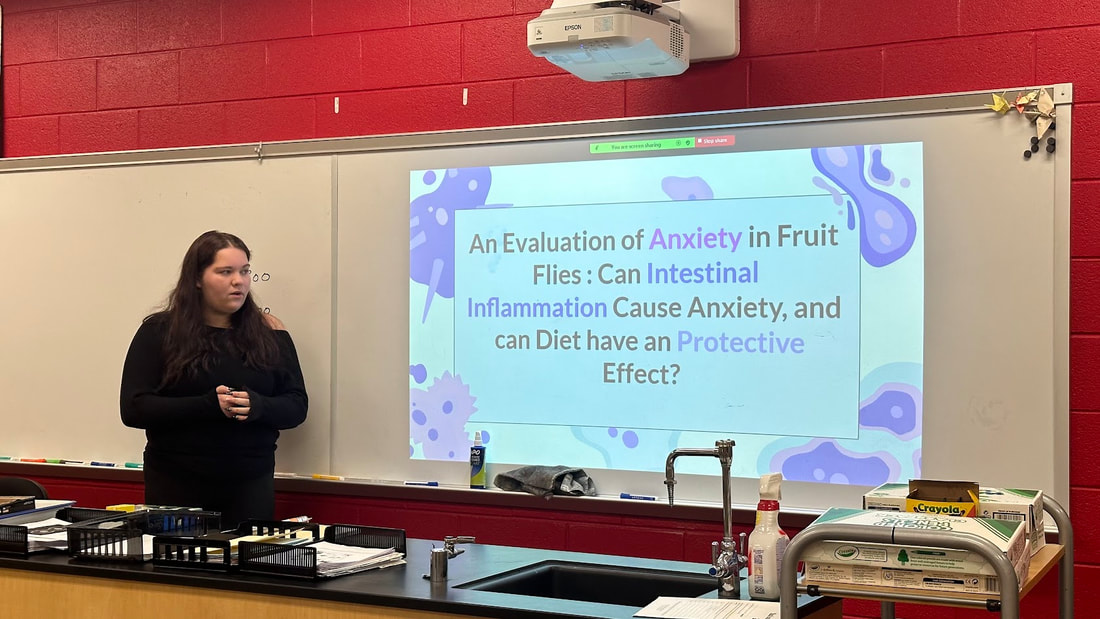
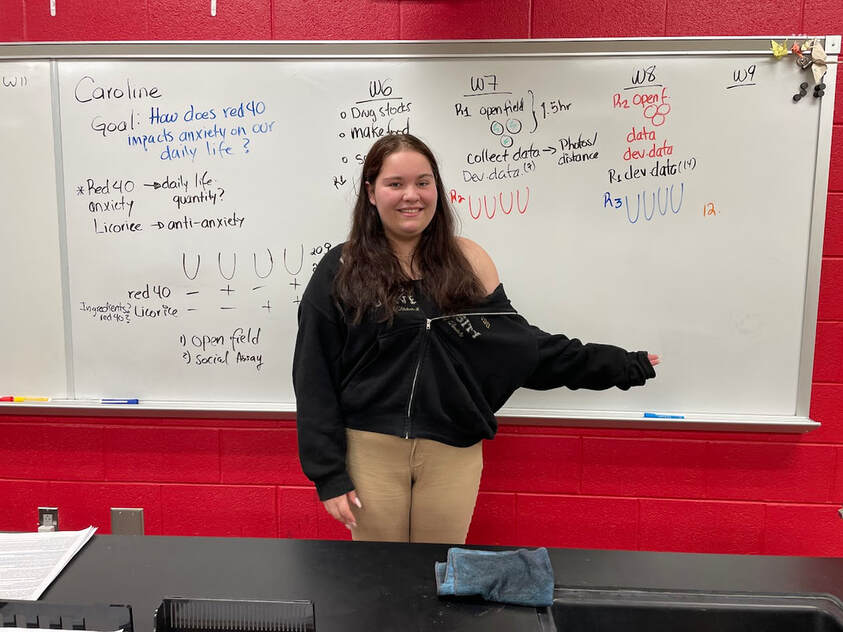
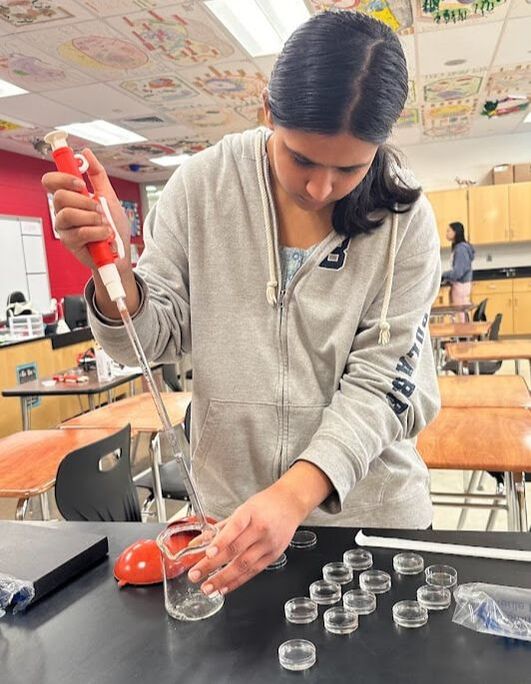
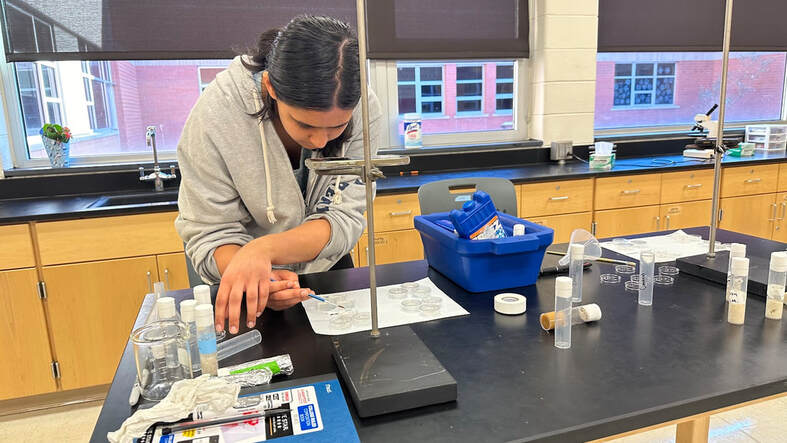
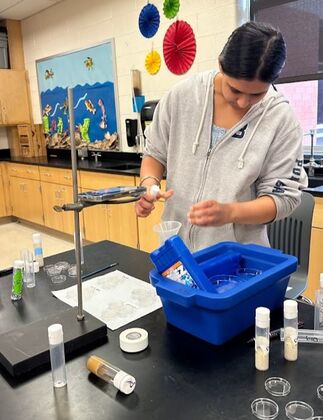
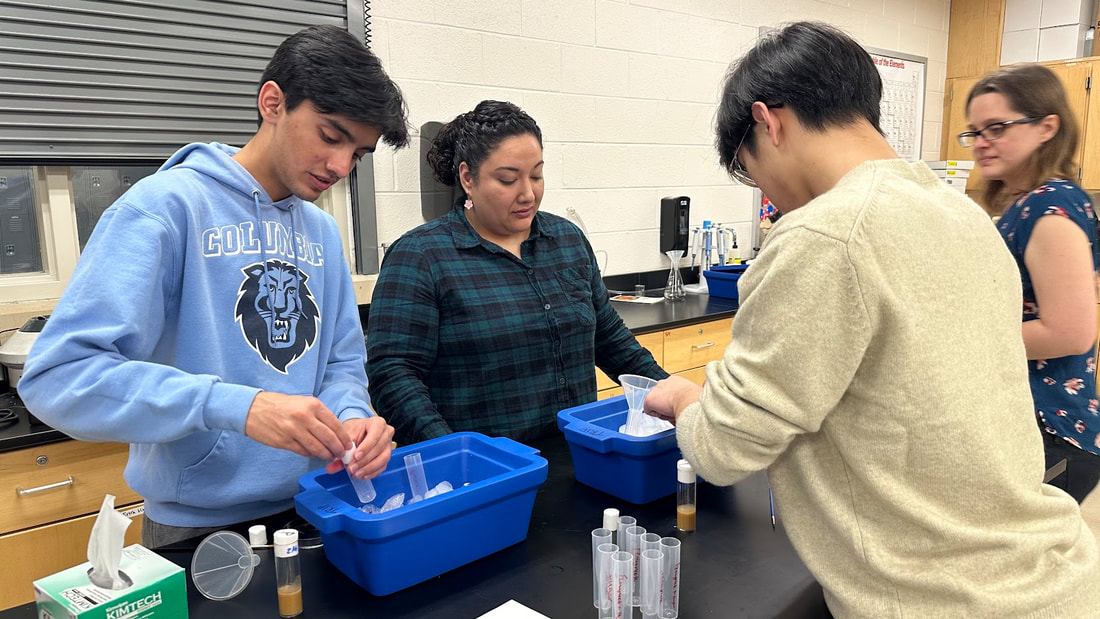
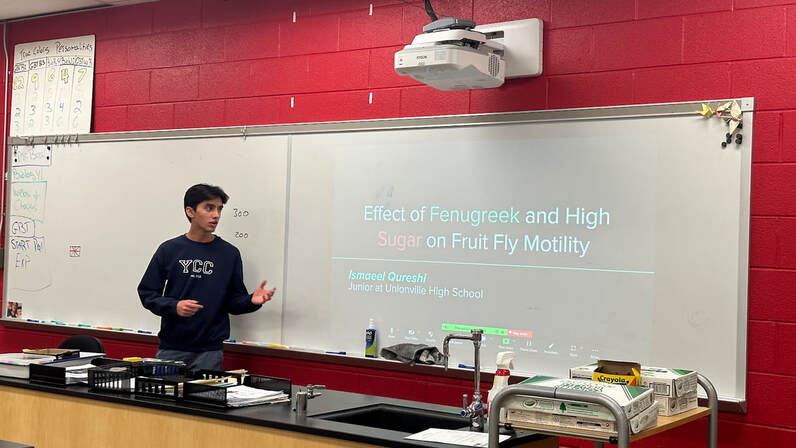
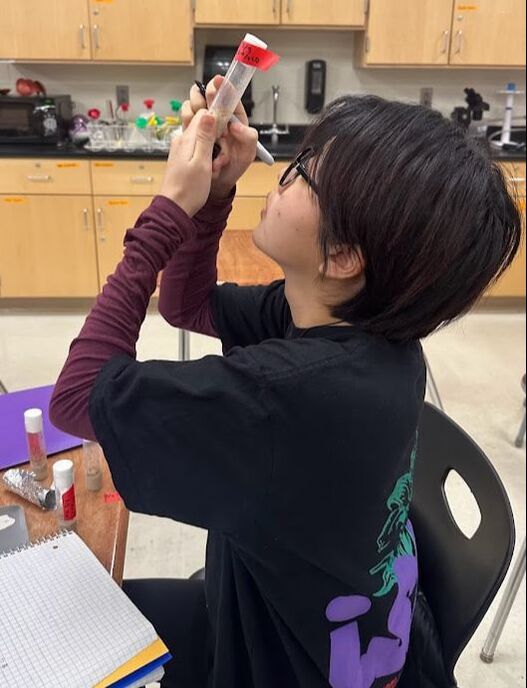
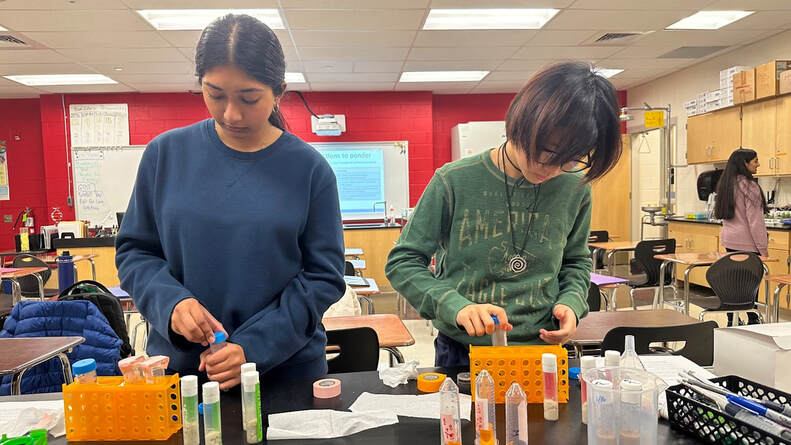
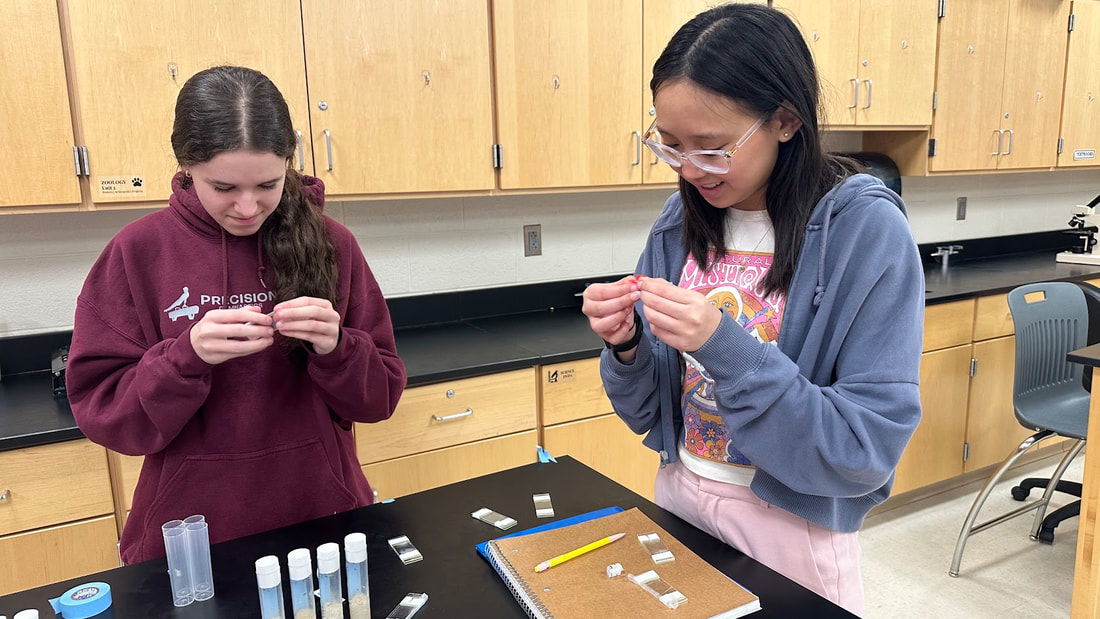
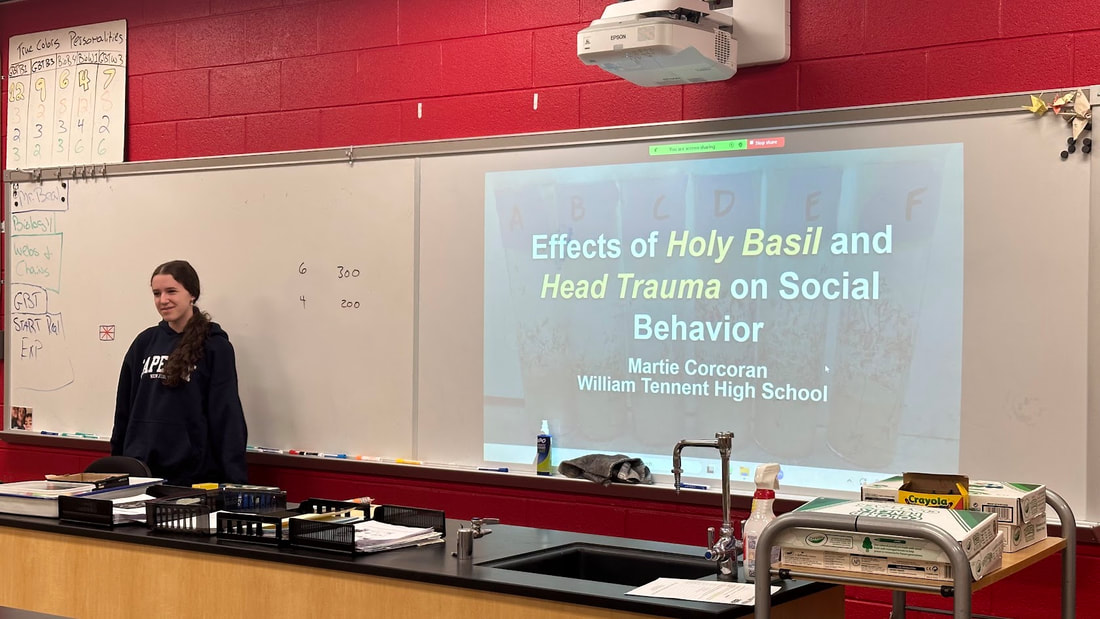
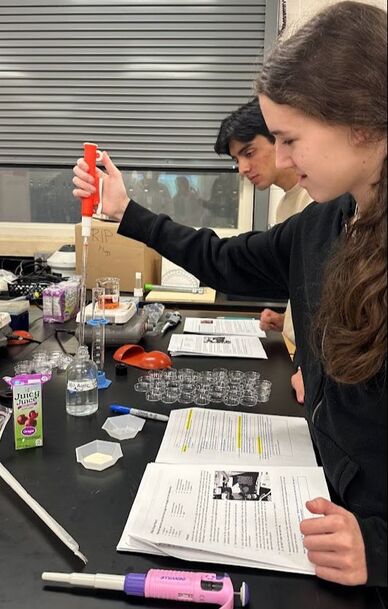
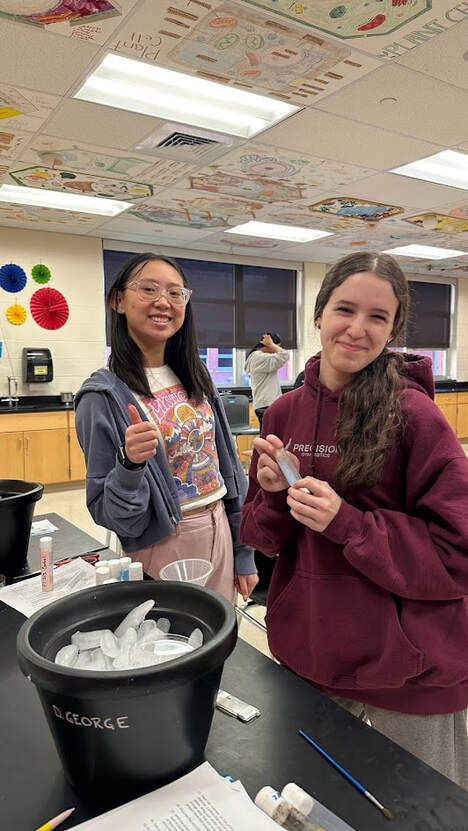



 RSS Feed
RSS Feed